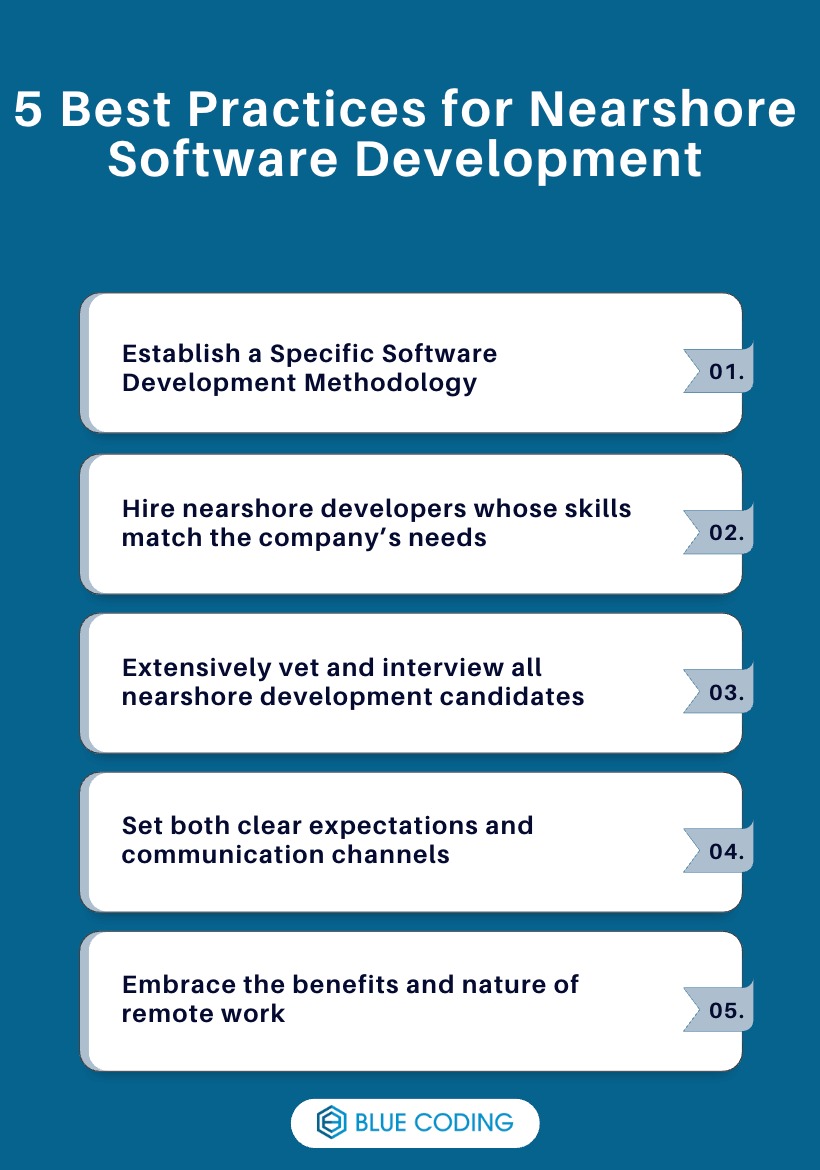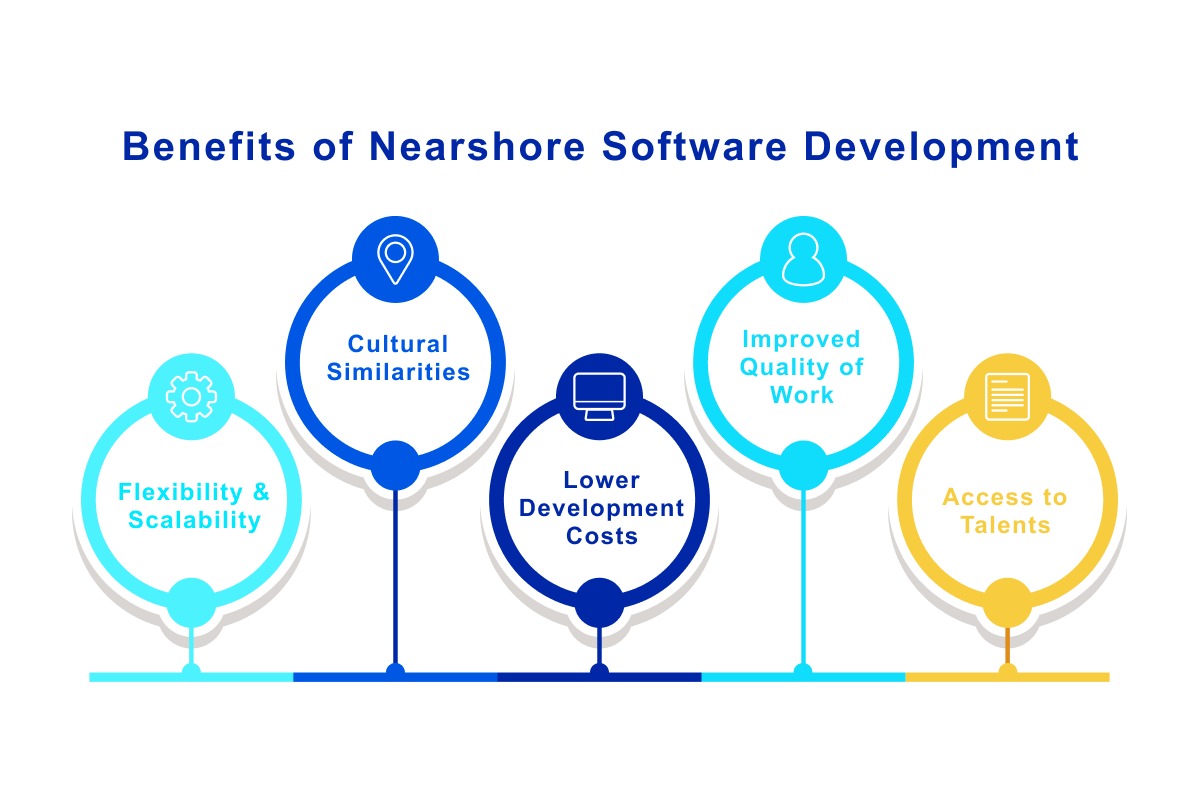 News
News
When it comes to our ever-evolving IT industry, companies are constantly searching for new ways to save money on development costs, speed up their recruitment processes, and increase team efficiency. Now, nearshore software development is a popular solution to modern coding needs and an alternative to traditional recruitment techniques. This practice has been rapidly increasing in popularity for the past few years, especially after the COVID-19 pandemic, having grown a shocking 98% during 2022. However, nearshore development has its own set of best practices that need to be followed in order to ensure maximum success with this outsourcing strategy. In this article, we will discuss the key practices for nearshore software development so your company can take full advantage of nearshoring moving forward.
What is Nearshore Software Development?
Before diving into the best practices for nearshore software development, it’s important to first understand the definition of nearshore software development. Nearshore software development is a process in which companies outsource their software development needs to developers located in nearby countries. This IT hiring strategy allows North American companies to benefit from much lower development rates and the opportunity to access a larger talent pool than what may be available in their own countries, especially given the repeated IT talent shortages of recent years.
Now, while many will be quick to compare nearshoring to offshore outsourcing and point out the slightly pricier services of nearshore development, this outsourcing strategy still possesses some unique selling points. To start, there are fewer time zone differences and language barriers when working with nearshore developers, thanks to the closer physical locations of the LATAM IT hubs, making communication and collaboration easier for both sides of the team. Another benefit of nearshore software development is the ability it provides to companies willing to leverage the local culture and experience of developers in other countries. By partnering with nearshore developers, companies can gain insight into different markets and cultures, allowing them to create more innovative solutions and better serve customers from all over the world.
5 Best Practices for Nearshore Software Development

1. Establish a Specific Software Development Methodology.
Project management in the IT industry is all about choosing the right methodology to work with for all development projects. This ensures consistency and will help you set a standard for any projects your distributed workforce work on during a nearshore software development arrangement. As of 2023, the top 4 software development methodologies are Agile, DevOps, Waterfall, and Rapid Application. Right now, the most popular one is Agile, but feel free to pick the one that fits your business the most. At the end of the day, choosing between these software methodologies will allow you to have a consistent project style and better organize all tasks pertinent to a certain development product your company is trying to finalize.
2. Hire nearshore developers whose skills match the company’s needs.
One of the main best practices for nearshore software development is to hire talent that matches the solutions to your IT problems. Companies should look for developers who have experience in their chosen language or technology stack, meaning the technology your organization needs to finish a certain development product. This will ensure that they have the necessary skills to complete all pending projects in a timely manner, whether that is a mobile or web application, and front-end or back-end work. There are certain red flags to look for in coding candidates, but not having a certain proficiency level in the technologies you’re recruiting for is the first and biggest one of them.
3. Extensively vet and interview all nearshore development candidates.
As with any recruitment strategy, it’s also important for companies to identify quality talent by conducting thorough background checks and interviews with all potential development candidates. This will help to ensure that only the most qualified developers are hired for the job. Furthermore, your organization should have clear guidelines for hiring and interviewing so that they can get an accurate assessment of each candidate’s skills, experience, and qualifications. Finally, conducting English proficiency examinations as part of the hiring process is a fantastic way to ensure there won't be any language barriers between your existing team members and your outsourced staff.
4. Set both clear expectations and communication channels.
Once a team of nearshore developers has been assembled, there are certain best practices for nearshore software development that should be followed in order to ensure a good working relationship with your new remote employees. The first step is to establish clear expectations and goals for the project or the role all nearshore developers will undertake in the following months. This will help to set a baseline for the project timeline - or the role’s day-to-day operations - and provide a reference point for all parties involved. Additionally, it’s important to establish clear channels of communication between teams so that updates and progress can be tracked easily and it’s easier to overcome any cultural or language barriers that may exist between teams. To do this, it is important to find a common channel that all remote staff members can use to communicate effectively.
5. Embrace the benefits and nature of remote work.
Remote work has several advantages, but the nature of this type of working relationship is slightly different from what a full-time in-person role looks like. If you want to have a successful nearshore software development experience, it’s key for you to embrace the ins and outs of having a distributed workforce. This means allowing flexible working hours, having a conversation about any existing time zone differences, and using tools for remote work in order to lead a more productive development team.
Nearshore vs. Offshore vs. Onshore: Which Is Right for You?
When it comes to outsourcing software development, businesses have three main options: nearshore, offshore, and onshore outsourcing. Each approach has its own advantages and challenges, making it essential to understand which one best fits your company's needs. Below, we break down the key differences to help you make an informed decision.
Nearshore Software Development: The Balanced Approach
Nearshore software development involves outsourcing to a neighboring or nearby country, usually within the same or similar time zones. This approach strikes a balance between cost savings and efficient communication. For example, U.S. companies often partner with Latin American developers, while European companies work with teams in Eastern Europe.
The main benefits of nearshore development include easier collaboration due to minimal time zone differences, cultural similarities, and cost savings compared to hiring locally. Additionally, language barriers are usually less of an issue, and travel is more convenient if in-person meetings are necessary. However, while nearshore outsourcing is generally more affordable than onshore development, it can still be pricier than offshore options.
Offshore Software Development: The Cost-Effective Choice
Offshore software development refers to outsourcing work to a country that is geographically far away, often with a significant time zone difference. Common offshore locations include India, China, and the Philippines. This option is particularly attractive to companies looking for the lowest development costs.
The biggest advantage of offshore development is affordability. Businesses can save a significant amount of money by hiring skilled developers in countries where wages are lower. However, the main challenges include time zone gaps, communication difficulties, and potential cultural differences that can affect collaboration. Additionally, managing offshore teams effectively often requires strong project management and communication tools to overcome delays and misunderstandings.
Onshore Software Development: The Local Premium
Onshore software development means hiring developers within your own country. This option is ideal for companies that need direct control over their projects and want to avoid communication barriers. Since there are no time zone differences or language issues, collaboration is seamless, making onshore outsourcing a great choice for complex or high-security projects.
The main downside is cost. Onshore development is the most expensive option due to higher labor rates in countries like the U.S., Canada, and Western Europe. While this approach provides high-quality work and easier compliance with local regulations, it may not be the best choice for companies looking to minimize expenses.
Which Option Is Best for You?
The right choice depends on your business priorities. If cost is your main concern and you can manage time zone challenges, offshore development may be ideal. If you want a balance between affordability and ease of communication, nearshore outsourcing is a great middle ground. And if you prioritize seamless collaboration and are willing to invest more, onshore development is the best fit.
Ultimately, the decision comes down to your budget, project complexity, and how much control you want over your development process. By weighing these factors, you can choose the outsourcing model that best supports your business goals.
How to Optimize Collaboration in a Nearshore Development Team
Nearshore development teams require more than just basic communication tools and scheduled meetings to work efficiently. Since these teams operate remotely but within nearby time zones, companies must implement structured collaboration strategies that account for technical dependencies, knowledge management, and cross-cultural alignment. Here’s how to ensure nearshore teams function at their highest potential.
Implement a Multi-Layered Communication Strategy
Basic messaging tools are not enough to manage a nearshore team effectively. Instead, organizations should implement a multi-layered approach that includes:
Technical Communication: Developers need dedicated spaces for discussing code, such as GitHub issues, pull request comments, or dedicated Slack channels for debugging. These ensure that all project-related discussions remain structured and traceable.
Project-Level Coordination: Tools like Jira, Asana, or ClickUp should be used to track development progress, dependencies, and blockers. Teams should also define “work-in-progress” limits to prevent bottlenecks.
Decision-Tracking Documentation: Major decisions should be logged in a shared Confluence space or Notion board. This prevents repetitive discussions and allows new developers to quickly understand past project choices.
Cross-Team Synchronization: For teams working on interdependent modules, regular sync meetings must include both the development and DevOps teams to ensure that infrastructure and deployment strategies align with coding efforts.
Use Domain-Driven Design to Structure Collaboration
In complex software development projects, domain-driven design (DDD) helps organize nearshore teams efficiently. This approach involves breaking down applications into bounded contexts, where each team owns a specific part of the domain. Nearshore teams should be assigned clear ownership of these domains, ensuring that:
Codebases remain modular and loosely coupled, reducing dependencies across time zones.
Teams work autonomously while following a shared architectural vision, improving parallel development.
Cross-team API contracts are well-defined, minimizing integration issues when different teams deploy updates.
Synchronize Sprint Planning with Distributed Decision-Making
Traditional sprint planning assumes that all developers are in a single time zone. Nearshore teams, however, need a different approach to prevent delays. The best way to optimize sprint planning for nearshore teams includes:
Using Async-First Planning: Teams document initial sprint objectives in a shared workspace before live planning meetings, allowing all members to contribute regardless of time zones.
Creating Role-Based Decision Trees: Instead of waiting for approvals from central leadership, nearshore developers should follow predefined decision trees that allow them to resolve minor blockers autonomously.
Implementing Decentralized Code Review Processes: Each sub-team should have its own reviewers, reducing bottlenecks caused by reliance on a single team lead or architect.
Build a Knowledge Graph for Cross-Team Collaboration
One of the biggest challenges in nearshore development is maintaining institutional knowledge across distributed teams. A knowledge graph—a structured representation of relationships between different parts of the project—can help nearshore teams:
Quickly identify which teams own specific modules of the codebase.
Understand dependencies between microservices, APIs, or shared components.
Reduce onboarding time for new developers by providing a clear map of system architecture.
Companies can use graph-based documentation tools like Obsidian, Neo4j, or Dendron to visually map project knowledge and allow developers to quickly find relevant information without searching through disconnected wikis or Slack threads.
Implement Automated Feedback Loops for Performance and Code Quality
Since nearshore teams work remotely, organizations should automate key collaboration processes to improve efficiency. The most effective feedback loops include:
Automated Code Review Metrics: Tools like SonarQube or CodeClimate can provide instant feedback on code quality, reducing back-and-forth during pull request reviews.
CI/CD Pipeline Optimization: Nearshore teams should have automated testing and deployment pipelines to reduce delays between writing and shipping code.
Sprint Retrospective Analytics: Aggregating sprint feedback through AI-powered tools like RetroTool or Parabol helps identify collaboration pain points faster.
Ready to Get Started with Nearshore Software Development?
Overall, following best practices for nearshore software development is essential in order to ensure a successful project outcome. By understanding what nearshore software development entails, establishing proper vetting procedures for remote IT hiring, and following the best practices for a successful nearshoring experience, companies can benefit from cost savings while still receiving high-quality work from experienced developers in other countries.
Now, at Blue coding, we understand the many challenges of getting started with nearshore outsourcing when a company hasn’t had any prior experience with this methodology. That’s why we offer custom nearshore software development services to help organizations hire the right nearshore IT professionals to join their teams. Thanks to many years of nearshore outsourcing experience and a large network of LATAM developers, our team is able to place the right developers into your company in a matter of days. This efficient hiring process will contribute to money-saving development results and better long-term outsourcing partnerships. Contact us today to schedule a free discovery call to learn more about our nearshoring services!




